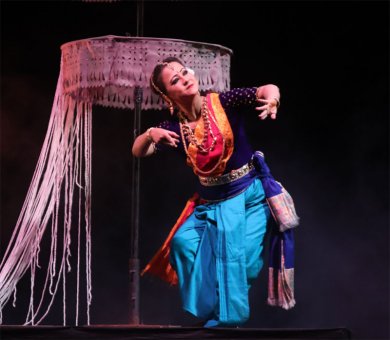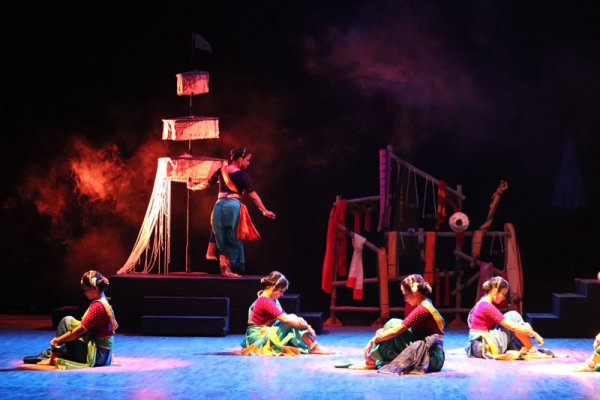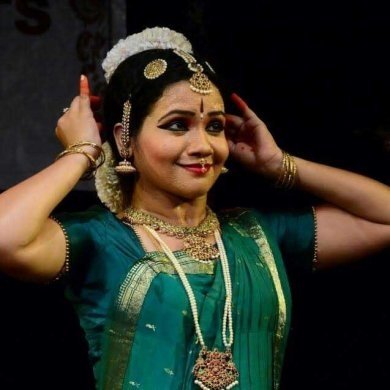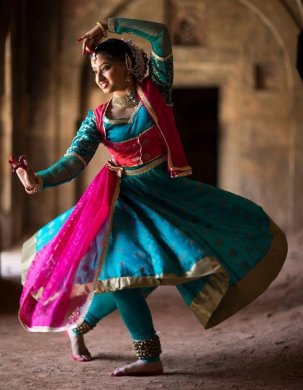
|   |

|   |
 e-mail: leelakaverivenkat@gmail.com Celebrating hundred years of Guru Bipin Singh's Manipuri Nartanalaya September 20, 2018 Manipuri Nartanalaya is synonymous with its founder late Guru Bipin Singh, who has left behind a legacy of innumerable good students and a fund of goodwill, with programs in his memory organized all over the country for a year now. Heralding 100 eventful years from August 23, 1918 to August 23, 2018, when yeoman service has been rendered to Manipuri, by spreading its message to different parts of India and even abroad, a special event in Kolkata as a thanksgiving to this institution and its Guru, sponsored an evening of a group expression - Ghana Baari Barikhata: Reflections in a Raindrop - comprising a part of Manipuri's very traditional repertoire of songs as part of the rites of living, tracing the pangs of a nayika. On an evening sponsored by Darshana Jhaveri and Srimati Kalanidhi Devi of Manipuri Nartanalaya, one only had to hear the fulsome observations of all the distinguished guests during the inauguration, to know what a significant influence Guru Bipin Singh was on Manipuri. A traditionalist with a very contemporary mind, he worked with the belief that tradition while necessarily changing to be relevant to the people of each age, had to be anchored in the eternal verities prescribed by the texts.  Seasons and their impact on all living beings as part of the cycle of life have been an inalienable part of all our art forms. And the Monsoons as the harbingers of new life with their waters slaking the thirst of parched Earth after the heat of summer, have been celebrated from time immemorial - right from the Vedas, and poetic descriptions on the Season symbolizing fertility, love and lovers, separation and unity - all an indivisible part of this season. Performed by disciples of Manipuri Nartanalaya, the concept, choreography and direction by Guru Bipin Singh's daughter Bimbavati - a fine artist with a good eye for group choreography - was based on music by N. Tiken Singh and Suman Sarkar, script by Amit Dasgupta, light designing by Uttiya Jana and stagecraft by Neel Kaushik. Very strong in the collective images presented, in the opening scene of Ghana Baari Barikhata, essentially woven round the nayika Radha's moods, is Radha's first view of Krishna from her balcony (attalika darshan), resulting in tears of love, of anticipation, of long separation coming to an end, rolling down her cheeks. This lyric is often sung in Manipuri Natasankirtan. The music on the Pena, a typical Manipuri instrument, had a soulful effect. The next segment brought in teental macha of 7 beats. The Saajat Tanum more like the tarana has movement based on rhythmic syllables exploring the gait of birds and animals. The Chataka birds, the Chakravaka, the cuckoo bird the harbinger of rains and the melancholy peacock, all desire rain to slake the thirsty earth. Change in mood sets in with the massive clouds marching like trumpeting elephants with the thunder, and rain drops fall on the dry earth making circular formations like coral necklaces. Movements express the rejoicing of all living beings, and the abhisarika (a recreated version by Bimbavati of what her father Bipin Singh had choreographed, with the bols and interludes changed by Tiken Singh and Suman Sarkar) has a totally different take from the usual abhisarika interpretation.  Here, Radha in the courtyard of her home plays out the entire scene of her setting out to meet Krishna with all the imagined impediments on the way. Vyakul Radha removing her anklets to avoid detection through the telltale sounds, slowly searches her way through darkness, the lightning flashes acting as benefactor brightening the Yatra pathway for her komal (tender) feet. In the Jhulan Yatra celebration during Sravan, when the Divine and the devotee swing together, (the song Jhoolongusangari, written by late Guru Bipin Singh in Brajbhasha) is succeeded by the Rath Yatra in month of Asadh - both celebrations captured through colourful sequences. The arrangement at one end of the stage on a raised platform at the back, decorated with coloured scarves hanging (as from tree branches), with a toy swing hanging from a branch on which is seated the idol of Krishna, with Khartal Cholom movements being rendered in front is followed by the Rath Jatra scene with ropes (signifying cords of love) being pulled, with Jagannatha Ashtakam "Kadachit Kalindi.." heard in the background. There was a fleeting tableau of inconsolable gopis as Krishna in his chariot leaves for Mathura - all part of the presentation with the lingering impact of the gopis' feet moving to silence without the music very powerful. After a quick flash of Dashavatar with sounds of "Jaya Jagadeesha Hare'', the sudden silence as an artistic device had a deafening impact. The one flaw in a very well rehearsed event was the fact that some of the male dancers, who seemed to be freelancers, while rhythmically correct, lacked the swinging grace and light footedness of full time Manipuri dancers, and this diluted the total visual effect in places. IIC inaugurates double bill concerts IIC has started concerts with two artists per evening, one from Delhi and the other from outside. The first in this package featured Bharatanatyam dancer Geeta Sirisha, a disciple of K.R.S. Prasanna and now the couple Sandhya and Kiran Subramaniam in Bangalore, and Varsha Dasgupta, a student of Abhimanyu and Vidha Lal, son and daughter-in-law of senior Kathak Guru Gitanjali Lal, whose mature guidance also forms part of Varsha's Kathak training.  Geeta Sirisha Geeta who runs Nataraja Art Academy began with an invocation to the three manifestations of female divinity Lakshmi, Saraswati and Parvati, rendered to music set in the Ragamalika form in Sree, Durga and Mohanam. Performing to recorded music, now an accepted part of proscenium presentations (with the ability to afford live music beyond most organizations), the impact on the audience certainly is not the same. The varnam in Ramapriya ragam, a composition by Mahesh Swamy, with statements attributed to Sita in Ashokavan, has expansive narrative passages eulogizing Rama's achievements in the Treta Yug, like saving the Yagna of the Rishis from pollution by the rakshasas, the resurrection of Ahalya, the breaking of Shiva's Bow to win the hand of Sita, and of the dutiful son who to save the father's honour, selflessly abdicates the throne to be in exile for fourteen years. But the main thread bringing everything together is Sita's cry "Baarai Raghuvamshachandra ba Kaushalya sutane" earnestly calling out to the shining star of the Raghuvamsha clan, the son of Kausalya) - the underlying suggestion being of why one who has achieved so much so easily has not yet come to rescue her. And herein lay the sthai bhava (dominant mood) that the dancer totally missed, till the end. That the impassioned description of Rama's great feats by Sita, were made in her desperate state of imprisonment, never came through in the interpretative passages with each episode becoming an enthusiastic theatrical narrative in itself, missing the underlining intent. Even in the charanam line where Sita pleads that he come, the solfa passages with veeshar adavu movements had a robust feel, not in keeping with the sentiments expressing Sita's urgency of wanting to be rescued. While nritta passages are independent, they cannot detract from the integrated feel of the varnam tone. The Kshetrayya padam "Nanne pendladu sumi naayanaa muvvagopala" which is in Pantuvarali originally, was announced as Kamavardhini, though it was really sung as a ragamalika with only the first line in Kamavardhini. Actually the Padam is the address of a Parakiya Kanya prevailing upon Krishna to marry her, promising that she will see that her people ask for no bride money from him. The rest of the song refers to how she was wooed by him and taught the ways of love by him. Interpreted by the dancer as representing three types of women - the mugdha, the madhya and the praudha - approaching Muvvagopala one by one, each trotting out reasons for why he has to marry her was confusing. Treated as three stages of the same woman led by Krishna from the unawakened mugdha state into one experienced in the ways of love, would have been more true to the sahitya. As it was, one was left confused. The javali 'Apadorukulaitinai' portraying the mugdha who is distressed about her innocent acts being misconstrued, with people gossiping about her as a flirt, was interpreted with conviction and the singing on tape too was good. There was no time for the tillana end.  Varsha Dasgupta The Kathak recital by Varsha Dasgupta, had, unlike recitals of this ilk, worthwhile music with Gitanjali Lal conducting the recital with her padhant. The excellent singer Pavitra Chari unfortunately in the opening Shiva Stuti "Mahadeva Shankara" in Hamsadhwani set to 12 beats went unheard with both pakhawaj and tabla playing together and poor balancing of sound. The dance composed by Vidha and Abhimanyu was efficiently done, with clean footwork. The crisp teental nritta with an excellent rhythmic treatment of 4 1/2 matras was immaculately presented with Gitanjali's excellent vocalisation of the bols. The abhinaya part choreographed by Gitanjali Lal "Baithi soche Brij baam suna lage mero dhaam, tum na aye to kya saharna hui" set to music in Maru Behag, portrayed the nayika's yearning for Krishna even while going through her daily activities like filling the pitcher with water drawn from the well. Well trained, and with the ability to emote, Varsha with more internalization can make the interpretative aspect even more intense. The Na Dhin Dhin Na drut aspect in teental with Mayur gat, jhoola, the rains and finally some quick parans made for a brief but well thought out recital. The dancer would do well to do away with the heavy choker covering her entire neck, its shine irritatingly taking attention away from even the dancer's face. Why do dancers want so much glitter in their clothes?  Writing on the dance scene for the last forty years, Leela Venkataraman's incisive comments on performances of all dance forms, participation in dance discussions both in India and abroad, and as a regular contributor to Hindu Friday Review, journals like Sruti and Nartanam, makes her voice respected for its balanced critiquing. She is the author of several books like Indian Classical dance: Tradition in Transition, Classical Dance in India and Indian Classical dance: The Renaissance and Beyond. Post your comments Please provide your name and email id when you use the Anonymous profile in the blog to post a comment. All appropriate comments posted with name & email id in the blog will also be featured in the site. |